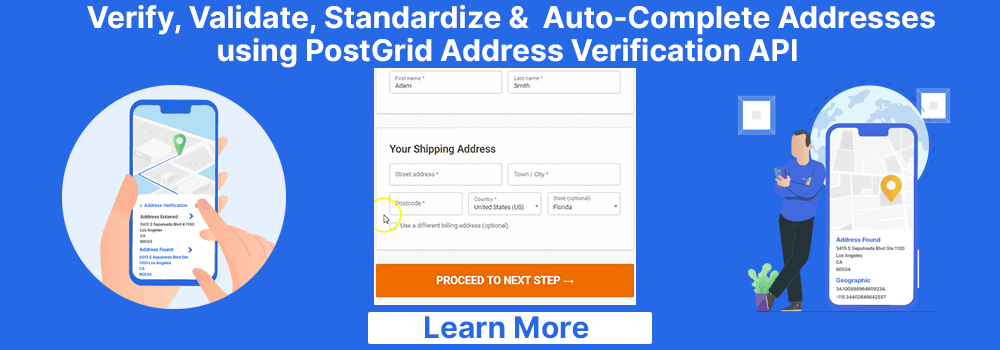
Why Is Your Address Not Valid While Sending a Mail in Canada?
If you are someone who has often accessed the postal service from Canada Post, then it is likely that you have come across a situation where the postal service does not recognize your address. Anyone who moves around a lot and changes their address has probably experienced this significantly more often than others.
Having their address tagged as invalid can be very worrisome for the recipients because they may miss important documents sent to them, and some of them may be time-sensitive. The chances are that you are here because you’ve had a similar problem in either receiving or sending such postal mail via Canada Post.

An address is termed invalid by Canada Post if it does not match a corresponding address in their official address database. There are several reasons behind this mismatch, and most often, this reason is either incorrect data or the given address is marked “vacant” by Canada Post. Any address that is new or unregistered will also fail to be validated as a deliverable address.
Additionally, any address located within a postal code that is predominantly serviced via PO boxes is also considered invalid. The best approach you can take to ensure that you or the recipient receives the postal mail is to verify the addresses beforehand.
In this article, we discuss the answers to questions like “Why is my address not valid?” and “Why isn’t my address recognized?” and discuss the reasons behind why addresses fail to get validated by Canada Post. We further discuss how you can carry out address verification or validation before sending out postal mail. We also take a look at bad addresses and how they can impact your business operations and elaborate on the steps you need to take to get your address recognized by Canada Post.
The article also explains what needs to be done in case of an invalid address, along with every nifty detail you need to know about address validation.
How to Carry Out Address Validation
Despite having one of the best business operations and a well-managed address database, many businesses and individuals still fail to verify some addresses. This can be frustrating for businesses and other organizations because they often put in an earnest effort to keep a clean address database and avoid bad data.
So when your addresses are shown as invalid and returned to you even after you’ve taken all the right steps, it can be quite disheartening. However, it is also true that Canada Post has a perfectly logical reason to classify an address as invalid.
It is not surprising that businesses and organizations are looking for a way to avoid such bottlenecks in their address validation process. But, before you start looking for ways to fix the process, you will need to know what is broken in your existing address validation process first.
To help you find what you could be doing wrong, we will explain below how an ideal address verification or validation process works. Understanding the process will help you see how you have entered an invalid address into your address database with respect to Canada Post standards.
Explaining Address Validation
Address validation, also more popularly known as address verification, is a process that verifies or validates a given address by comparing it against the corresponding address in Canada Post’s official address database. An effective address validation or verification process consists of three major steps, and following them will decide the quality of your address database.
This also means that if your address validation or verification process follows the steps below consistently, then it is highly unlikely that you will get a return mail due to an invalid address.
So what are the three major steps involved in address validation?
The three steps for effectively address validation using an advanced address validation tool are as follows.
- Address Standardization and Parsing
- Checking With Canada Post Database
- Returning a Value
Now that we know what steps are involved in address validation or verification, let us see what each of these steps means.
Address Standardization and Parsing
The first step to an effective address validation or verification process is to standardize the given address so that you rectify any incorrect formatting of the address. This means you have to organize every part of the address, such as house number, street name, city, postal code, etc.
Apart from that, you will also need to make sure that the spelling and even the abbreviations you’ve used are in the correct format. The correct format we are referring to here is the official standards directed by the postal system.
For example, “Main Street” in an address is changed to “Main St.” and similarly, the state “Alberta” would need to be changed to “AB.”
The abbreviations are not all that’s involved in address standardization. A proper address standardization process also includes formatting the address, such as putting the house number before the street name and so on. This is important because the address needs to be compared or matched against Canada Post’s official address database, and it also plays a role in how fast the mail is processed once you send the mail.
Furthermore, this step also addresses minor errors and corrects them; these could be spelling mistakes or misplaced abbreviations, and so on. Apart from correcting misspelled street names or cities, this step would also update the address in case there is any minor piece of information missing from it.
However, this does not mean that address standardization is a magical process that can convert any address to a real, deliverable one. Like everything else, address standardization also has its limitations, and it can only take you so far. In other words, there is very little you can do if the customer has intentionally or unintentionally given you the wrong street name.
Similarly, address standardization can’t be of much help if important details such as the street name are missing.
On the flip side, it is possible that the street number can be deducted so long as the postal code and the street address you’ve provided are correct.
To get a better understanding of how address standardization works, let us take the following example:
Correct Address: Mr. John Smith 5-4658 Barter Street Vancouver BC V6B 2N9
Incorrect Address: John Smith #5 4658 Barter St. Vancouver, British Columbia V6B2N9
Given above is the correct and incorrect version of a hypothetical address. Now let’s assume that the above incorrect address has a wrong street designation, misspelled city, and a missing postal code and that it is submitted for standardization.
Considering that the incorrect address provides sufficient information for context, the address standardization process can do its thing in this case. This means fixing any issues such as incorrect street designation, spelling mistakes, or even a missing postal code won’t be a problem as long as you have the other relevant information.
However, the situation would be different if the address we submitted for standardization had been different, such as the one given below.
Uncorrectable Address: Jane Doe 123 Middle Street TN ON M5V 2T6
The above address has the wrong address number, an incorrect street name, and the wrong abbreviation for the state. In such cases, address correction is not possible because there is no context here, and without it, the address remains incorrect even if you use an advanced address verification tool.
This is where the other half of step 1: address standardization and parsing, comes into the picture.
Address Parsing is a simple process where the given address is dismantled into pieces or lines of data. Each piece of data is then identified as distinct parts and labelled accordingly. This is a practice that is often employed in address verification or validation processes because not only does it make your job easier, but it also makes it much more organized.
By doing so, you can effectively reduce the chance of unnecessary errors. Furthermore, address parsing also significantly helps you simplify the standardization and validation processes. Apart from this, you can also identify the moving parts in an address properly, thanks to parsing.
As a result of address parsing, it becomes easier to fill or correct the relevant data that may not be possible by using the standardization process alone. In effect, parsing offers you a better chance of successful address validation or verification, even if you have somehow written down the wrong address and forwarded it for address validation.
However, there are downsides to parsing because, unlike standardization, parsing is not what you might call foolproof. As compared to address standardization, the parsing process often runs into minor issues. This includes its inability to differentiate between pieces of data being misplaced in an address. And although parsing is carried out in conjunction with standardization by most, that’s not necessarily the case every time.
Also Read: How to Use Real-Time Address Lookup to Mail Accurately?
Checking With Canada Post Database
Once the address in question has completed the standardization and parsing processes, it can proceed to the next step, which is checking it against the official address database of Canada Post or any other relevant database. After completing the address standardization and parsing process, you are left with a standardized address, meaning that any minor mistakes in the address have already been corrected.
Furthermore, the address after parsing is in the exact format as the official standards, which is also the one followed by the database against which the address will be checked. The database in question must be an authoritative one that dictates the standard for the postal system that you use.
The official address database of a country is almost always under the control of its official postal service provider, and in Canada, Canada Post is the country’s official postal service provider.
The database of Canada Post holds the address of every citizen of Canada, and therefore not everyone can access the database.
You need to be a SERP-certified service provider to access the sensitive data, and even then, you’d still need to make use of a standardization API to ensure the safety of the data. This is why using an advanced address validation or verification tool like PostGrid is important. Unless and until you use an advanced tool like PostGrid or create one yourself, you must be prepared to face the – please provide a valid address and statement.
That being said, it should be relatively easy to carry out the address verification if you only have a very limited number of addresses that need to be validated or verified by using a native solution from Canada Post. However, you’d still need to search using the address that has been standardized if you want to get the best result, regardless of whether you use a native or advanced third-party solution.
Once the search is done, the address you’ve provided is compared to Canada Post’s official address database. If a match is found in the country’s database for your address, then it is classified as “validated,” meaning the address is real and deliverable.
So, this brings us back to the original question, why is my address not valid? The easy answer is that the given address is not listed on the official address database kept by Canada Post and, therefore. As far as the Canada Post system is concerned, that address does not exist because it couldn’t find the same in Canada Post’s database.
Any such address is marked “invalid,” and there is no secondary filter or reexaminations in the process. That being said, when it comes to the practical side of things, it is not necessary that your purpose for validating an address is to send postal mail. Sometimes, the address validation is carried out simply to verify that the address is real.
Verifying or validating addresses for the purpose of knowing whether they are real or not is usually a prerequisite to merging and managing a company’s customer database.
So, what does this mean for your address validation process? It means that even though the Canada Post has accurate data on minions of addresses, this data is still limited to the addresses to which Canada Post delivers and does not include the undeliverable addresses. This is another point where using a native solution for your address validation can be troublesome for you.
Again, the best choice will be to use an advanced address verification tool like PostGrid that can access the Canada Post database and additional public and private sources.
 Also Read: What is Address Autocomplete?
Also Read: What is Address Autocomplete?Returning a Value
Once your address has been parsed, standardized, and checked against the official address database of Canada Post, it will be ready to return a value that indicates whether an address is valid or not. In this last step, the address data is returned to the user, and the returned value is either valid or invalid. Some service providers even go so far as to elaborate on why an address did not get validated or explain what part of the address could not be validated.
This can be helpful for figuring out what is wrong with your addresses and may even help you find some kind of pattern that may be indicative of some operational error.
Furthermore, depending on the service provider you choose for your business, you may even get access to additional information that can prove vital for your other business operations as well. The additional information compiled by the service provider may include data like geocodes corresponding to each address, RDI labels, or even information regarding the time zone.
As you can see, the additional information you can access may be nonexistent or exhaustive in nature, and the information you get is entirely dependent on the service provider you’ve chosen. Such additional information can help you optimize other business operations, including your marketing efforts.
 Also Read: Fuzzy Address Searching
Also Read: Fuzzy Address SearchingReasons Behind Address Validation Error or Invalid Address
The all-important question of “why is my address not valid?” can not really be answered with a single word, but bad data comes close to the answer you are looking for. There are several reasons for address validation errors or invalid addresses, and we will discuss some of the major ones below.
Bad Data
Suppose we had to give one major reason for addresses turning out as invalid bad data, which means data that is not accurate. But when it comes to the verification of addresses, bad data is not just inaccurate data; it is the data that does not satisfy the standards defined by competent authorities.
This includes not just errors in data but also in the formatting of the address that is fed in for address verification. You could even say that every other error observed in the address verification process is a variation of bad data.
Input Error
One of the most common reasons behind invalid addresses in your address database is, unsurprisingly, human error. Today’s address database is almost always in the digital format, and the traditional way of keeping addresses has long gone. The only time human involvement is necessary for your address database is during input, and the error rate during the input is much higher than one might expect.
It is also worth noting that many companies get this data directly from their customers through their websites and landing pages. The user may intentionally or unintentionally enter the wrong address, and the best way to counter this is by implementing an auto-complete feature. You can accommodate an auto-complete feature by integrating an advanced address verification API like PostGrid into your website.
Incorrect Information
Incorrect information is very similar to Input Errors because the end result for both is inaccurate information. However, unlike input errors, incorrect information can occur at any point and not just during input. Putting the wrong street name, city name, or postal code is an example of incorrect information. As long as the address’s error is significant and uncorrectable via the standardization process, that address will be classified as invalid.
Missing Information
It is not necessary that your address is returned as invalid because you provided the wrong data because providing no data can also have the same result. You may even argue that providing no data is even worse than providing incorrect information because the standardization process can fix up minor errors in your data.
However, regardless of how good a process you have, you simply can not guess the street name or house number of an address out of the blue. Although it is possible for you to verify the accuracy of the city, state, and postal code relationship, it’s of no use if the system can’t come up with a full address. So the one mistake you must avoid even more seriously than wrong information is missing information.
Falsified Information
Today, it is easy to access large data, but the challenge is finding accurate and reliable data. There is a lot of fake or falsified information floating around, and it is up to you to pick the right ones while steering away from bad data. People often falsify information because they don’t want to reveal their real identity/information.
Sometimes, users sign up for programs to benefit from the program mandates that they submit their information. Regardless of what their reason might be, falsified data simply will not get validated and show up as invalid. You must avoid falsified information if at all possible and encourage your customers to submit accurate data.
Area Not Serviceable
Sometimes it is possible that you have the right address and still get your mail returned to you simply because the postal service provider you use does not provide their service to that particular area. Typically these addresses are in a PO box-only postal code in Canada or war-affected areas in a foreign land.
However, these are just two examples, and broadly speaking, this could be any locality where the postman/woman does not make a house call. Simply put, any address that can not receive postal mail is not registered in the Canada Post database. So any postal mail that you send to any such address will get returned, and furthermore, the address will also show up as invalid upon validating or verifying it.
Address Not Registered
Anyone residing inside Canada needs to register their address with the county’s postal service authority, Canada Post, if they want to receive their postal mail. It goes without saying that postal service providers like Canada Post are not obliged to keep track of every new address. The onus is upon the recipients to sign up for the postal service as they are the stakeholders in the case.
All Canada Post does is keep track of the records accurately so that they know where the postal mail needs to be sent. There are no special treatments when it comes to Canada’s postal service, and any address that is not registered in the Canada Post system will turn up invalid.
New Address
New addresses are very similar to addresses that are not registered with Canada Post. Similar to the above point, moving to a new place is your business, and Canada Post does not keep track of your whereabouts. So, if you don’t wanna miss out on your postal mail, you need to notify Canada Post about the address change.
Furthermore, there is also the chance that your important postal mail gets sent to your old address, and a new tenant may receive your personal mail. There is also the chance that the mail gets blocked because they wouldn’t want to needlessly hold on to your mail. So failure to inform Canada Post about your new address could potentially lead to another invalid address.
Address is Unoccupied
Any address that is unoccupied that no one is there for registering the address with the postal service provider. Such addresses are also absent from the official address database. So, even if the address is real, it will be classified as invalid because, as far as the Canada Post database is concerned, such an address does not even exist.
The address Does Not Exist
Sometimes the address you are looking for simply does not exist. The reason for this could be anything. Maybe the building to which the address belongs recently got condemned or demolished, or maybe the address is just not used anymore.
But, more often than not, such addresses never existed from the beginning, and there is no point in having a fictional address for Canada Post or anyone else for that matter. Therefore it should come as no surprise to you that such addresses are also returned as invalid.
 Also Read: Google Address Validation
Also Read: Google Address ValidationHow to Get Canada Post to Recognize an Address?
Contrary to popular belief, getting Canada Post to recognize your address is not all that hard to do, but it may take a considerable amount of time to have it in effect. So, when it comes to getting your address recognized by Canada Post, the sooner you get the ball rolling, the better it is for you. Sometimes the process can take even months, and it is essential that you keep that in mind, especially if the address registration is for business purposes.
Another important thing you should know is that the addresses managed by the Postal Code Address Data (PCAD) of Canada Post enable the public to apply for address changes.
To do this, all you have to do is pay a visit to the nearest post office. Don’t want to visit the post office?
There is nothing to worry about; just click here and type in your city, state, and postal code. Once you have done that, you will be presented with all the details you need of your local post office, including their address and their phone number. You will be easily able to complete the necessary formalities required to change your address with the help of the post office so long as your address is added or connected to their system.
 Also Read: Ecommerce Address Validation
Also Read: Ecommerce Address ValidationIs an Address Deliverable Via UPS Valid for Canada Post Delivery?
At least some of you may think that an address deliverable through private postal carriers like UPS, FedEx, and DHL is also deliverable through Canada Post, but that’s not always the case. The truth is that most private carriers are often willing to go the extra length that the primary carrier won’t. They even offer a wide variety of options that pretty much covers object of all size and shape.
However, that does not mean their address database or postal service is superior to Canada Post. At best, they are more convenient in certain cases, and you will need to pay extra for that. That being said, if you want to send postal mail to addresses that Canada Post does not deliver to, third-party postal services can come in handy for you.
For example, if you have to send mail to a location that is primarily serviced via PO boxes, Canada Post will not make the delivery and will treat the address as invalid. In such cases, private carriers can take it to the destination because they do not deliver to PO boxes in the first place. Similarly, delivery to places that do not receive postal mail, such as warehouses, can also be accomplished using a private carrier. This also means that you can send huge packages; however, this is likely to burn a hole in your pocket. Then, there are also addresses that are not registered or are outside Canada Post’s service area. Such addresses can also be reached via postal mail using a private carrier.
The private carriers may seem like a good option when you consider their ability to deliver to places that primary can’t, but this comes with a price, literally! You will need to pay more, and if you are a business that regularly sends out direct mail, then you can guess how significant an amount you will be spending.
Furthermore, these private carriers also come with their own address validation tools, but the truth is that they can’t even begin to compete with the extensive database that Canada Post holds. For example, the FedEx tool has dodgy accuracy when it comes to the validation of addresses.
What to do When an Address is Returned as Invalid?
Whatever the reason may be, once a mail is returned to you as invalid, there are a few steps you can take after it happens. Below we explain what you can do when your postal mail gets returned, citing as an invalid address.
Double-Check Your Address
The first thing you can do is simply double-check the address you have written for any accidental errors. You will be surprised at how often people make mistakes, even at the very end, and furthermore, it can never hurt to take a second look at your postal mail.
Check For Common Error
The next thing you can do is check the address for common errors such as reversed numbers, spelling mistakes, abbreviations, etc. Although you may not find this important enough, there is a good chance that the postman/woman found it confusing.
Check Whether The Address is in a PO BOX Only Area
Once you have completed the first two steps, you can move on to the third one, where you check whether the address you want the mail delivered to is a PO Box-only area. Such addresses may be classified as invalid by Canada Post, and it is important that you check them.
Mail Without Worrying about Address Inaccuracy
Get an extended postal code lookup for your business and automate your offline marketing efforts to send out direct mail to your customers.
Conclusion
Addresses can turn out to be invalid for several reasons, and for businesses that regularly send out direct mail, it is important that you understand these reasons. You need to closely monitor your direct mail closely, particularly return mail that cites invalid addresses as the reason for non-delivery. It is important to analyze these reasons and make necessary corrections, if possible, to optimize your direct mail operation.
However, the best approach is to employ an advanced address verification or validation tool such as PostGrid to validate your address database. Validating your address database means you can easily minimize the return rate and also get access to the most extensive collection of address data from Canada Post. This way, you cannot only ensure the effectiveness of the operations but also have room for further growth.










